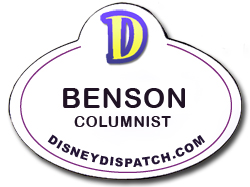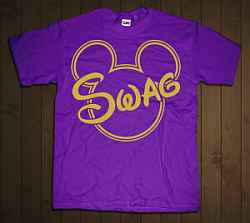FROM: It's All in a Nametag Published Thursdays
Disney Retail Nametags
Over the years, Disney has dabbled in retail. Everyone knows about the Disney Store, but who remembers Mickey's Kitchen? Benson Myers remembers. In this week's column, he presents a short analysis of Disney's retail ventures - and their nametags!
Recently, Disney CEO Robert Iger has been extolling the wondrous virtues of the Disney brand and his desire to "extend the Disney brand by embracing new digital media."
He has also expressed his desire to expand the Disney brand's visibility and accessibility. Is this a good direction? For the most part, yes.
But today let's discuss and remember some of the past experiments in Disney brand expansion, see how they fared, and what benefits they brought to the Company.
The Disney Store
The first Disney Store opened in 1987 in Glendale, California. With its focus on Disney-themed merchandise (some exclusive), the Disney Store catered to families and their love of all things Disney. Disney Stores opened in shopping centers, malls, and airports across the United States and Canada, and then internationally in Spain, Japan, and elsewhere.
However, with so many locations world-wide, the Disney Store began to be a victim of its own success. Employee quality and integrity became a severe challenge, and the Store faced extreme competition from high-volume retailers. Disney merchandise became available at competing retailers, such as WalMart, and the market soon became saturated.
click an image to expand and read notes:
Disney Store Nametag
Mickey's Kitchen Nametag
Club Disney Nametag
Disney CEO Bob Iger
In the late 1990s, the once-popular 'mall' concept in the United States began to falter, and many locations hosting a Disney Store went into bankruptcy and closed entirely. So, faced with such severe competition, and too many locations, the Disney Company announced in 2004 that it would sell the Disney Stores to The Children's Place, which would operate them as a licensed entity. However, the management of the Disney Stores by The Children's Place was considered inefficient, and not up to Disney Standards.
So, in 2008, when The Children's Place announced it had filed for bankruptcy protection, the Disney Company decided to repurchase the Disney Store; close many of the smaller, less lucrative locations; and retheme the remaining Stores.
Bottom line for the Disney Store? It provided a successful, high-visibility market position for the Disney brand, at the cost of over-saturation and intense competition.
Mickey's Kitchen
Mickey's Kitchen was an experimental restaurant opened at a Disney Store location in Montclair, California. The restaurant was on an upper level, the Disney Store on the lower level. It was intended as an alternative to traditional fast-food locations, offering families nutritious food in a fun-filled Disney atmosphere.
Guests could enjoy low-fat Goofy hamburgers, vegetarian Pinocchio pizza, and French fries in the shape of Disney characters. While an initial success, Mickey's Kitchen faced strong competition from established fast food locations in the malls that had lower prices. In the end, Mickey's Kitchen never had the support it needed from the executives in Burbank, and in 1992, both of its locations closed.
Bottom line for Mickey's Kitchen? It did not survive intense competition from lower-priced rivals.
Club Disney
Opened as an activities center for children, Club Disney offered jungle gym-type structures, computer games, and pizza parties, including sleepover parties. Club Disney also offered educational activities, such as drawing and painting, and a chance for children to dress up and stage their own theatrical productions.
While successful with guests and a popular concept, Club Disney was not financially lucrative enough to justify the Company's investment. As a result, the five Club Disney locations in California, Arizona, and Colorado were closed in 1999. Club Disney was also a victim of a shift in corporate strategy within the Disney Company.
Bottom line for Club Disney? It wasn't profitable enough to justify the expense of keeping it open.
Retail Results
So there you have it. What can we learn from our examination? We see that while Disney-themed retail expansions can be successful and profitable, they must be managed with a great amount of care.
The Disney Store is the only one of the three concepts we've examined today that has survived to become part of the Disney establishment. But why is that? What makes the Disney Store different? It's mainly because it was the only truly profitable concept, and the only one to actually receive the necessary support from Corporate Disney in Burbank.
That's really the key.
Whatever the Disney Company decides to do with its brand, it must be supported Company-wide and not be seen as just an experimental concept. Consumers have a never-ending appetite for all things Disney, and it's up to the Company to provide them with high quality products at convenient but cost-effective locations.
More: IT'S ALL IN A NAMETAG
Stuff Not to Skip
- Benson Myers' Blog
http://mousebadges.blogspot.com/2010/12/disney-store.html - Benson Myers' Nametag Museum
http://www.nametagmuseum.com







